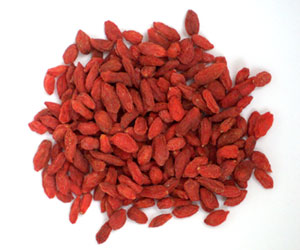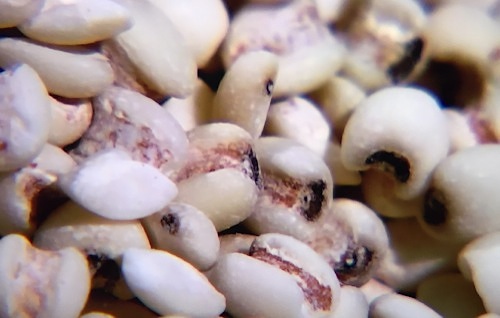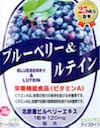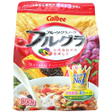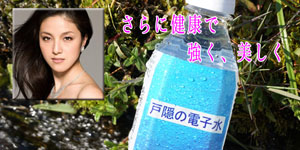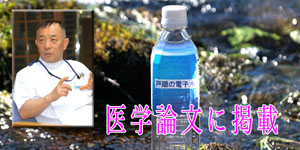
 ニゲラサティバ、ブラッククミン、ブラックシード、ブラックセサミ、Nigella Sativa、脳細胞を保護 ニゲラサティバ、ブラッククミン、ブラックシード、ブラックセサミ、Nigella Sativa、脳細胞を保護
たくさんの名前をもっていますね。
かなりスパイシー、胡椒っぽい。まちがっても一気に口に入れないこと。
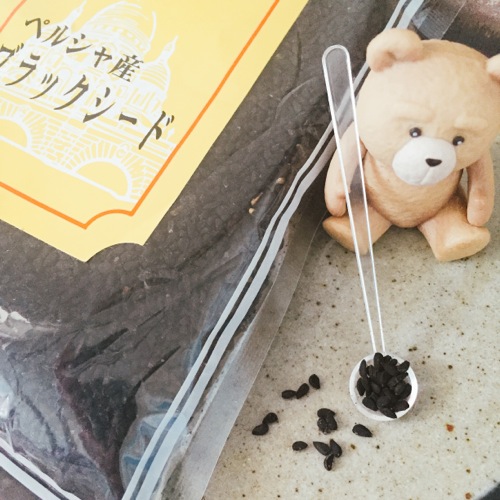
「死以外のすべての病気の治療薬となる」とイスラムの預言者ムハンマドが言ったらしい。
アラブ諸国では「聖なるオイル」
古代エジプトでは「ファラオオイル」
学名ニゲラサチバ(Nigella sativa L.)。キンポウゲ科の一年生草。日本名「匂黒種草(においくろたねそう)」。花がきれいで園芸でも人気があります。原産地はエジプト。俗称ブラック・クミン(クロクミン)。
インドや中東地方では、ニゲラサチバの種子は健康食として食べられています。また、種子を擦ったり砕いたりしたものはスパイスとしても有名で、インド料理を始め西欧でも使われています。
・加熱しないこと
・一日の目安
茶さじ1杯
・ブラッククミン(ニゲラサチバ、ブラックシード)のおもな成分
チモキノン
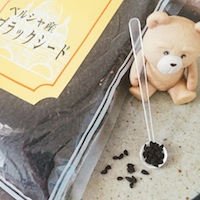
価格チェック☆楽天市場
【ブラックシード・最強の黒い種、ブラッククミン、ニゲラサティバ、ブラックセサミ】

参考

東京工科大学の研究チームが、ニゲラサチバの種子油に含まれるチモキノンがアミロイドβの神経毒性から脳細胞を保護する作用があることを発見しました。
2013年、東京工科大学の研究チームは、ニゲラサチバの種子油に含まれる「チモキノン」が、アミロイドβの神経毒性から脳細胞を保護する作用があることを発見しました。
ニゲラサチバ種子油は、ブラッククミンシードオイル等の名称で販売されています。
インドや中東地方では、ニゲラサチバの種子は健康食として食べられています。また、種子を擦ったり砕いたりしたものはスパイスとしても有名で、インド料理を始め西欧でも使われています。
種子から絞った油は、「ブラッククミンシードオイル」または「ブラックシードオイル」という名称で販売されています。
http://認知症症状.com/news/thymoquinone/

March 23, 2013
チモキノン(ブラッククミンシード精油化学成分)の炎症疾患およびがん治療の可能性
Thymoquinone: potential cure for inflammatory disorders and cancer.
チモキノン:炎症疾患およびがん治療の可能性
Thymoquinone チモキノン
PUBMEDより
Woo CC, Kumar AP, Sethi G, Tan KH.
Source
Department of Pharmacology, Yong Loo Lin School of Medicine, National University of Singapore, Singapore 117597, Singapore.
シンガポール国立大学医学部
Abstract
要旨
Thymoquinone is an active ingredient isolated from Nigella sativa and has been investigated for its anti-oxidant, anti-inflammatory and anticancer activities in both in vitro and in vivo models since its first extraction in 1960s.
チモキノンはブラッククミンから単離された活性成分で、1960年の最初の抽出移行インビトロおよびインビボモデルの両方でその抗酸化、抗炎症および抗がん作用が調査されてきた。
Its anti-oxidant/anti-inflammatory effect has been reported in various disease models, including encephalomyelitis, diabetes, asthma and carcinogenesis.
その抗酸化/抗炎症作用は脳脊髄炎、糖尿病、喘息や発がんを含む様々な疾患モデルにおいて報告されている。
encephalomyelitis 脳脊髄炎
Moreover, thymoquinone could act as a free radical and superoxide radical scavenger, as well as preserving the activity of various anti-oxidant enzymes such as catalase, glutathione peroxidase and glutathione-S-transferase.
さらに、チモキノンはフリーラジカルおよびスーパーオキシドラジカルスカベンジャー、ならびにカタラーゼ、グルタチオンペルオキシダーゼ、グルタチオン-S-トランスフェラーゼなどの様々な抗酸化酵素の活性を維持するように作用することができる
The anticancer effect(s) of thymoquinone are mediated through different modes of action, including anti-proliferation, apoptosis induction, cell cycle arrest, ROS generation and anti-metastasis/anti-angiogenesis.
チモキノンの抗がん作用は、抗増殖、アポトーシス誘導、細胞周期停止、ROSの生成および抗転移/抗血管新生を含む異なる作用機序を介して媒介される。
anti-proliferation 抗増殖
apoptosis induction アポトーシス誘導
ROS. reactive oxygen species. 活性酸素種.
anti-metastasis 抗転移
anti-angiogenesis 抗血管新生
In addition, this quinone was found to exhibit anticancer activity through the modulation of multiple molecular targets, including p53, p73, PTEN, STAT3, PPAR-γ, activation of caspases and generation of ROS.
また、このキノンは、p53遺伝子、p73遺伝子、ピーテン酵素、STAT(シグナル伝達兼転写活性化因子)、ピーピーエイアールガンマタンパク質、カスパーゼの活性およびROSの生成を介して抗がん作用を示すことが見出された。
quinone キノン
一般的にはベンゼン環から誘導され、2つのケトン構造を持つ環状の有機化合物の総称である
http://ja.wikipedia.org/wiki/%E3%82%AD%E3%83%8E%E3%83%B3
The anti-tumor effects of thymoquinone have also been investigated in tumor xenograft mice models for colon, prostate, pancreatic and lung cancer. The combination of thymoquinone and conventional chemotherapeutic drugs could produce greater therapeutic effect as well as reduce the toxicity of the latter.
また、チモキノンの抗腫瘍作用は大腸がん、前立腺がん、膵臓がんおよび肺がんの腫瘍異種移植マウスモデルで調査されてきた。チノキモンと従来の化学療法薬剤との併用はより大きな治療効果を生むだけでなく、化学療法の毒性を減らすことができだろう。
tumor xenograft mice models 腫瘍異種移植マウスモデル
conventional chemotherapeutic drugs 従来の化学療法薬剤
In this review, we summarize the anti-oxidant/anti-inflammatory and anticancer effects of thymoquinone with a focus on its molecular targets, and its possible role in the treatment of inflammatory diseases and cancer.
このレビューで、我々はその分子標的、および炎症性疾患および癌の治療におけるその役割の可能性に焦点を当て、チモキノンの抗酸化/抗炎症および抗がん作用を要約する。
用語
p53遺伝子(ピー53いでんし)とは、一つ一つの細胞内でDNA修復や細胞増殖停止、 アポトーシスなどの細胞増殖サイクルの抑制を制御する機能を持ち、細胞ががん化したときアポトーシスを起させるとされる
http://ja.wikipedia.org/wiki/P53%E9%81%BA%E4%BC%9D%E5%AD%90
p73遺伝子は、ヒトのさまざまな癌で異常の見られることが多い染色体1p36.3領域に存在するうえにp53の標的遺伝子をトランス活性化するが、p73が腫瘍抑制因子として機能するのかどうかはわかっていない
p73-deficient mice have neurological, pheromonal and inflammatory ...
http://aromahonjin.way-nifty.com/blog/2013/03/post-5bd9.html

December 08, 2012
強力な鎮痛剤および抗炎症剤としてのブラッククミンシード精油(マウスの実験)
Black cumin seed essential oil, as a potent analgesic and antiinflammatory drug.
強力な鎮痛剤や抗炎症薬としてブラッククミンシード精油。
PUBMEDより
Phytother Res. 2004 Mar;18(3):195-9.
Hajhashemi V, Ghannadi A, Jafarabadi H.
Source
Department of Pharmacology, School of Pharmacy and Pharmaceutical Sciences, Isfahan University of Medical Sciences, Isfahan 81746-73461, Iran.
Abstract
要旨
The steam-distilled essential oil of Iranian black cumin seed (Nigella sativa L.) was investigated for its composition and analgesic and antiinflammatory properties. After oil analysis by GC/MS, 20 compounds were identified in the oil, obtained in 0.4% (v/w) yield. Among them, para-cymene (37.3%) and thymoquinone (13.7%) were the major components.
イラン産ブラッククミンシード(Nigella sativa L.)の水蒸気蒸留精油は、その成分および鎮痛と抗炎症特性が調査された。GC / MSによる精油分析後、収油率0.4% (v/w)得られた精油には20の化学成分が同定された。そのなかで、パラサイメン(37.3%)と チモキノン(13.7%)が主要成分であった。
Nigella sativa L.:ブラックシード、ブラッククミンシード、キンポウゲ科
thymoquinone チモキノン
Acetic acid-induced writhing, formalin and light tail flick tests were used for assessment of analgesic activity. Antiinflammatory activity was evaluated using carrageenan-induced paw oedema in rats and croton oil-induced ear oedema in mice.
酢酸ライジング法, ホルマリンと光のテールフリックテストが鎮痛作用の評価に用いられた。抗炎症作用はラットのカラジーナン誘発足せき浮腫とマウスのクロトン油誘発浮腫を用いて評価された。
Acetic acid-induced writhing 酢酸ライジング法
Tail-flick test. テールフリックテスト(侵害反射が関与する痛覚感受性試験としてよく知られている)
analgesic activity 鎮痛作用
carrageenan-induced paw oedema カラジーナン誘発足せき浮腫
croton oil-induced ear oedema クロトン油誘発浮腫
Black cumin seed essential oil (BCSEO) was found to produce a significant analgesic effect in acetic acid-induced writhing, formalin and light tail flick tests. Naloxone, an opioid antagonist, could not reverse the analgesic effect observed in the formalin test.
ブラッククミンシード精油(BCSEO)は酢酸ライジング法、ホルマリンと光のテールフリックテストで有意な鎮静作用を産生することが解明された。オピオイドきっ抗薬のナロキソンはホルマリンテストで観察された鎮痛作用を逆転することができなかった。
opioid antagonist オピオイドきっ抗薬
Although oral administration of BCSEO at doses of 100, 200 and 400 micro L/kg did not exert a significant antiinflammatory effect in the carrageenan test, i.p. injection of the same doses significantly (p < 0.001) inhibited carrageenan-induced paw oedema. BCSEO at doses of 10 and 20 micro L/ear could also reduce croton oil-induced oedema.
100, 200 and 400 micro L/kgの容量でブラッククミンシード精油(BCSEO)の経口投与はカラジーナンテストで有意な抗炎症作用を発揮しませんでしたけれども、同容量の腹腔内投与はカラジーナン誘発足せき浮腫を有意に(p < 0.001)阻害した。また、左の耳に10 および20マイクロ容量のブラッククミンシード精油(BCSEO)はクロトン油誘発浮腫を減少させることができた。
i.p. intraperitoneal administration 腹腔内投与
It seems that mechanism(s) other than opioid receptors is (are) involved in the analgesic effect of BCSEO since naloxone could not reverse this effect.
ナロキシンはこの作用を逆転できなかったので、オピオイド受容体以外のメカニズムがブラッククミンシード精油(BCSEO)の鎮痛作用に関与しているように思われる。
Both systemic and local administration of BCSEO showed antiinflammatory activity. Thymoquinone, as one of the major components of BCSEO, probably has an important role in these pharmacological effects.
ブラッククミンシード精油(BCSEO)の全身および局所投与の両方は抗炎症作用を示した。ブラッククミンシード精油(BCSEO)の主要成分・チモキノンは、多分、これらの薬理作用に重要な役割を持っていました。
http://aromahonjin.way-nifty.com/blog/2012/12/post-aea7.html

Nigella sativa (black-caraway,[2] also known as nigella or kalonji), often called black cumin,[3][4] is an annual flowering plant in the family Ranunculaceae, native to south and southwest Asia.
Nigella sativa grows to 20–30 cm (7.9–11.8 in) tall, with finely divided, linear (but not thread-like) leaves. The flowers are delicate, and usually colored pale blue and white, with five to ten petals.
The black caraway fruit is a large and inflated capsule composed of three to seven united follicles, each containing numerous seeds which are used as spice, sometimes as a replacement for black cumin (Bunium bulbocastanum).
Common names
In English, Nigella sativa and its seed are variously called black-caraway, black-cumin, fennel-flower, nigella, nutmeg-flower, Roman-coriander,[3] and kalonji (from Hindi).[6]
Blackseed and black caraway may also refer to Bunium persicum.[7]
Culinary uses
Nigella sativa seeds
The seeds of Nigella sativa are used as a spice in Indian and Middle Eastern cuisines. The black seeds taste like a combination of onions, black pepper and oregano. They have a pungent bitter taste and smell.[6]
The dry-roasted nigella seeds flavor curries, vegetables and pulses. It can be used as a "pepper" in recipes with pod fruit, vegetables, salads and poultry. In some cultures, the black seeds are used to flavor bread products. It is also used as part of the spice mixture panch phoron (meaning a mixture of five spices) and by itself in many recipes in Bengali cuisine and most recognizably in naan bread.[8] Nigella is also used in Armenian string cheese, a braided string cheese called majdouleh or majdouli in the Middle East.
History
According to Zohary and Hopf, archaeological evidence about the earliest cultivation of N. sativa "is still scanty", but they report supposed N. sativa seeds have been found in several sites from ancient Egypt, including Tutankhamun's tomb.[9] Although its exact role in Egyptian culture is unknown, it is known that items entombed with a pharaoh were carefully selected to assist him in the afterlife. Seeds were found in a Hittite flask in Turkey from the second millennium BCE.[10]
The earliest written reference to N. sativa is thought to be in the book of Isaiah in the Old Testament, where the reaping of nigella and wheat is contrasted (Isaiah 28: 25, 27). Easton's Bible dictionary states the Hebrew word ketsah refers to N. sativa without doubt (although not all translations are in agreement). According to Zohary and Hopf, N. sativa was another traditional condiment of the Old World during classical times, and its black seeds were extensively used to flavor food.[9]
The famous Persian physician Avicenna, in his Canon of Medicine, describes N. sativa and mentions in particular its use for dyspnea.[11]
Chemistry
Nigella sativa oil contains conjugated linoleic (18:2) acid, thymoquinone, nigellone (dithymoquinone),[12] melanthin, nigilline, and trans-anethole.[6]
Medicinal use
N. sativa has a long history of use as medicine. Modern clinical trials have begun to investigate its efficacy, mainly using the seed oil extract, volatile oil, and isolated constituent thymoquinone.[13] The most trials, and those of the best quality to date, provide preliminary support for its use in asthma (for both prevention and treatment of acute attacks), allergic rhinitis, and atopic dermatitis.[14] Smaller and less rigorous studies suggest it might help people with functional dyspepsia, respiratory problems due to mustard gas poisoning, seizure disorders, diabetes mellitus and the metabolic syndrome, and opioid addiction.[14] One meta-analysis of clinical trials concluded that N. sativa has a short-term benefit on lowering systolic and diastolic blood pressure, and another found that various extracts of black seed can reduce triglyercides, LDL and total cholesterol while raising HDL cholesterol.[15][16]
https://en.wikipedia.org/wiki/Nigella_sativa
より
価格チェック☆楽天市場
【ブラックシード・最強の黒い種、ブラッククミン、ニゲラサティバ、ブラックセサミ】
|


